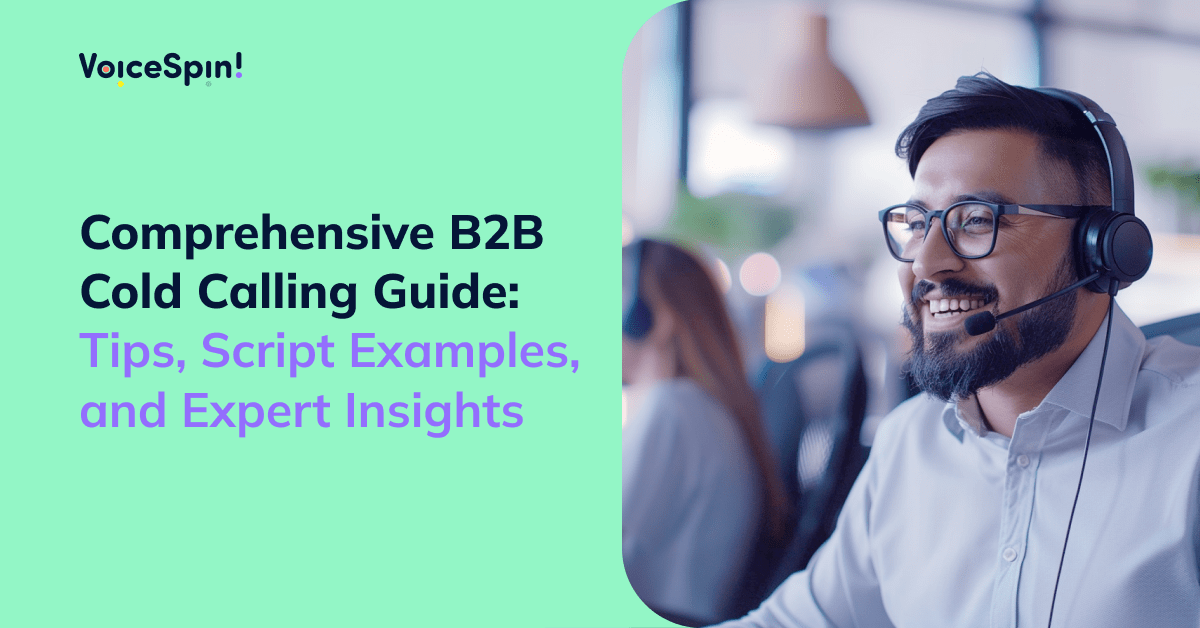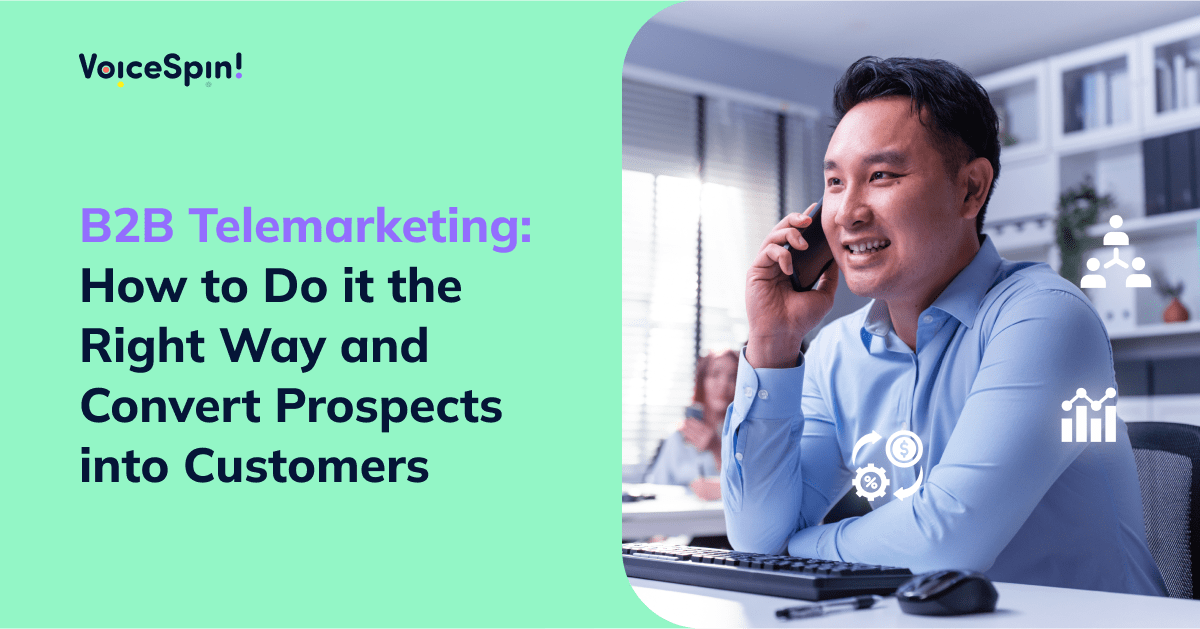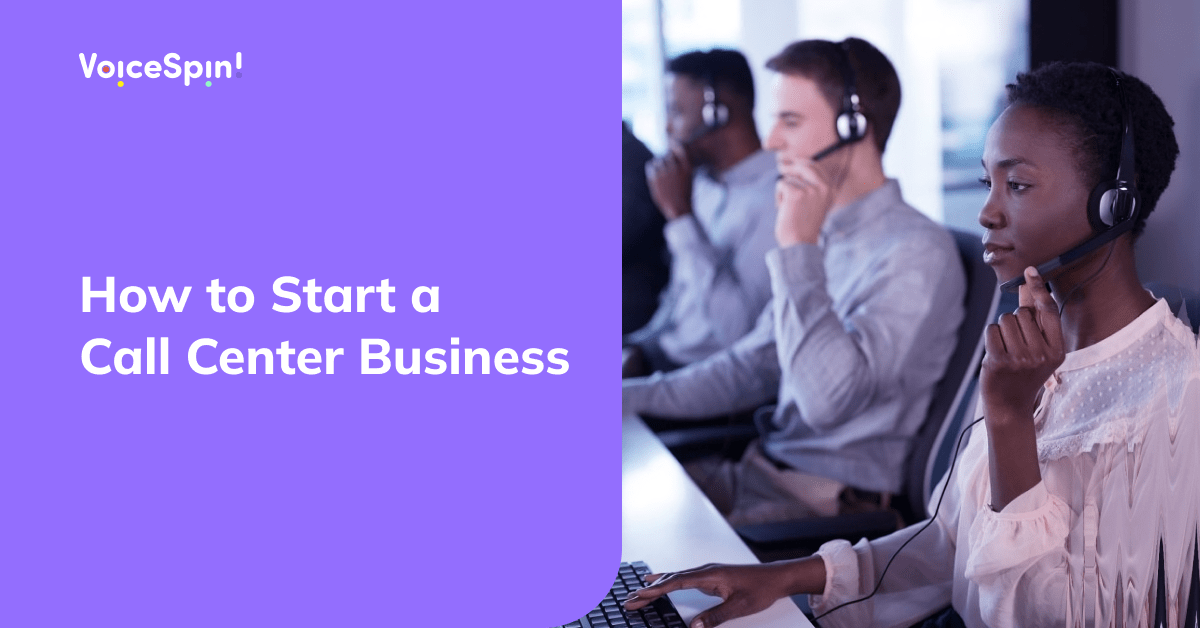Though some consider cold calling an outdated marketing tactic, many companies – from startups to Fortune 500s – still rely on cold calling to generate fresh leads and drive their business revenue. And for B2B businesses, in particular, cold calling remains highly relevant and impactful despite the rapid rise of digital marketing strategies.
Even though, most probably, cold calling prospects is something your sales reps would rather NOT be doing (who wants to be consistently rejected by strangers, right?) – it’s cheaper than PPC ads and yields faster outcomes than your content marketing and SEO efforts. Plus, with cold calling, you get the added advantage of making a personalized human connection and an opportunity to establish relationships with your prospects from the get-go.
Since VoiceSpin has been in the B2B industry for over 15 years already, our own sales experts have extensive experience and expertise to share when it comes to building efficient B2B cold calling strategies – and we have asked one of them to share some valuable insights. In this blog post, we’ve outlined some tried and true B2B cold calling tactics you can implement in your cold calling process, along with helpful cold calling scripts and expert tips from our VP of Sales to set your sales team up for success and help your sales reps close more deals faster.
What is B2B Cold Calling, and Why is it Essential in B2B Sales?
B2B cold calling is a sales practice of attempting to sell a product or service to prospects who haven’t previously reached out to your brand and, most probably, haven’t even heard of you. This contrasts with warm calling, where prospects might have signed up for your trial or demo, downloaded an e-book, or filled out a lead capture form on your website.
When cold calling, your prospects aren’t expecting a call from you. With a ridiculously low average success rate for cold calls (around 2% compared to 40% when calling warm leads) – no wonder 63% of salespeople consider cold calling the worst part of their job.
Yet, B2B cold calling presents an excellent opportunity to proactively reach out to your potential audience and engage in meaningful one-on-one conversations, helping you create personal connections, uncover the specific needs of your prospects, and stand out with a highly personalized offering – something that you won’t be able to do through digital channels alone. And when done strategically, it does bring impressive outcomes. Research from Crunchbase found that organizations that don’t cold call experienced 42% less growth than those who used the tactic.
On top of that, while cold emails or ads can easily be overlooked or simply ignored by your prospects, a well-executed cold call at the right time can help you get through to key decision-makers, cutting through the noise of digital clutter, and build credibility and trust, which is the foundation to establishing long-term business relationships.
Top B2B Cold Calling Tips and Best Strategies to Follow in 2024 and Beyond
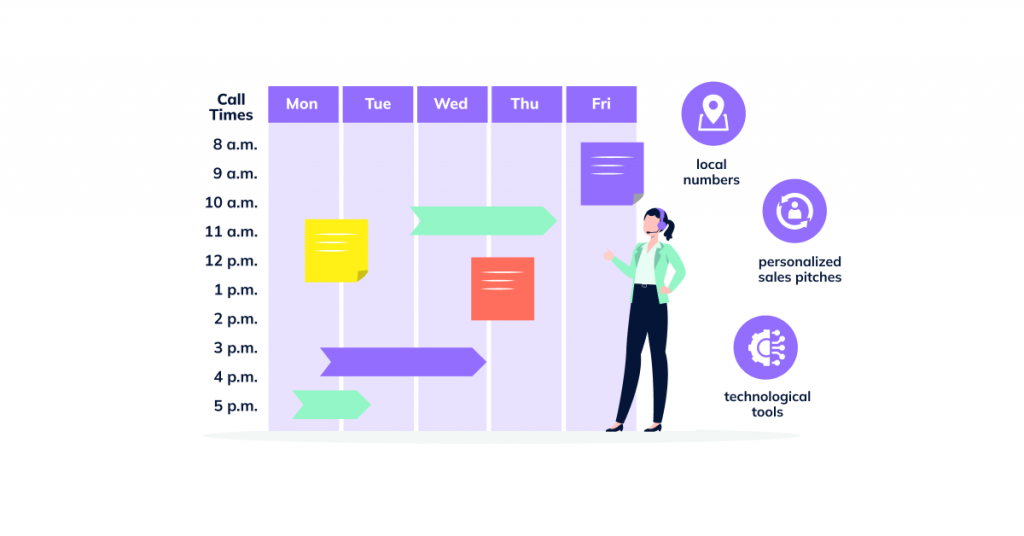
Pick the right times to cold call your prospects
The first and one of the most important things you can do to improve your cold calling strategy is to make sure your team chooses the optimal times to make cold calls to your potential customers. Of course, it’s only one small aspect to pay attention to, but it does make a significant impact. If your team manages to catch your prospects when they are more receptive to taking calls and aren’t busy with high-priority tasks, that can increase your call connection rates, ensuring your reps can handle more outbound calls, and help you improve conversions. Research proves that calling prospects during the recommended times can increase the average gain in conversions by 49%.
So, what is the best time to cold call your potential customers? While there’s actually no such thing as a “best time” to cold call, various studies have found that late mornings and late afternoons tend to have the best response rates for cold sales calls. For example, a study conducted by Yesware found that weekday afternoons are the best times to make cold calls; while the majority of calls lasting over five minutes occur between 3:00 – 5:00 PM on Tuesdays or Thursdays.
According to another research conducted by CallHippo, the best time of the day to make cold calls is between 4:00 – 5:00 PM, following the second best time to cold call between 11:00 AM – 12:00 PM. And what’s particularly remarkable, the study revealed that the difference in the number of conversations between 4:00 to 5:00 PM and the number of conversations between 11:00 AM to 12:00 PM is 71%.
Here’s another example. A study by Revenue.io claims that decision-makers are more likely to engage in the late afternoon, with the best times to cold call between 4:00 – 5:00 PM. This peak engagement window is followed closely by the 3:00 – 4:00 PM and 5:00 – 6:00 PM hours.
You might want to check more research findings in our blog The Best Times to Cold Call Prospects in 2024.
Use local numbers to boost your call answer rates
A low call answer rate is one of the biggest challenges businesses face when running outbound cold calling campaigns. Even if you’re calling at the recommended times and have perfectly crafted sales scripts, that won’t make any sense if you can’t get through to your prospects in the first place. While there might be many reasons why your prospects aren’t picking up, the majority just won’t answer if they see a call from an unknown number.
However, you can dramatically change that if you use local numbers when running your outbound calling campaigns, which means your prospects will see a number with a local area code on the caller ID. A study by Software Advice found that people are four times more likely to answer unknown calls from local numbers. That is why using local numbers can be a game-changer for your sales team.
Luckily, many outbound call center software solutions offer local presence dialing, enabling you to call your prospects from local numbers. E.g., with VoiceSpin’s outbound calling software solution, you can purchase local DID numbers from 160+ countries and set to display local caller ID in your auto dialer settings, helping you boost your call connection rates and improving the efficiency of your cold calling efforts.
Research your prospects and personalize your sales pitch
The success of your B2B cold calling attempts greatly depends on your sales team’s ability to personalize each interaction and customize their sales pitch based on who they are calling to. That’s why it’s always worthwhile to research your prospects and their companies beforehand. Your potential customers don’t want to feel like they are just another name on your cold calling list – you need to show that you’ve done your research and can speak to their individual needs.
In the age of Google and LinkedIn, finding relevant background information on your prospects and the companies they represent isn’t rocket science. LinkedIn is truly an excellent place to get information that can serve as ice breakers (like the recent posts your prospects shared or what college they attended).

In addition, take some time to look over your prospect’s website to get a deeper understanding of their company, business needs, and specific pain points they might be experiencing. Overall, getting a clear picture of who’s going to be on the other side of the line builds a solid foundation for making successful cold calls.
Start with a proper opening statement
Your opening statement sets the tone for the entire conversation, and the way you start off and introduce yourself can make a huge difference. There are two critical things to remember when it comes to opening a conversation on a cold call. Firstly, make sure you properly introduce yourself by providing your full name and the company you represent upfront. Otherwise, you might hear questions like ‘Who is this?’ or ‘What company are you with?’, which basically means you’re putting a prospect in control.
Secondly, certain opening phrases should better be avoided altogether, such as, for instance, ‘Did I catch you at a bad time?’. Despite once being the go-to opener for sales reps, data from Gong.io shows that using this phrase in your opening statement reduces your chances of setting a meeting with a prospect by 40%. At the same time, opening a B2B sales cold call with ‘How have you been?’ resulted in a 10.01% success rate, while opening your cold call by stating the reason for calling can increase your success rate by over 2x times. That being said, here’s what your opening statements may look like:
“Hi Bryan, this is John Smith calling from [Company name]. How have you been? Bryan, the reason I’m reaching out today is to discuss how our [product/ service] can help you reduce your operational costs by 30% and improve your team’s efficiency. Is this something you’d be open to exploring?”
“Hi Sam, this is John Smith calling from [Company name]. How have you been? Sam, I’ve been exploring companies in your industry, and I would love to discuss [specific challenges or pain points] and how our [product/ service] can help you overcome these challenges. Would this be of interest?”
“Hi Linda, this is John Smith calling from [Company name]. How have you been? Linda, we’ve been helping companies similar to yours achieve [a significant result]. I believe we could do something similar for [Prospect’s company name]. Is that something you’d like to hear more about?”
“Hi Oliver, this is John Smith calling from [Company name]. How have you been? Oliver, I’m calling sales-driven organizations in our industry to see if they’d benefit from our solution. To put what it does in a single sentence, we help sales managers [achieve a specific outcome]. Is this something that would be of interest to you?”
Get your cold calling scripts prepared but be flexible
Having well-thought-out actionable cold calling scripts at hand while making cold calls can truly help you navigate each conversation with greater confidence and ensure consistency in your messaging. However, you should only partially depend on it, using it rather as a guide that serves just to help you remember what to talk about and keep your conversation focused.
If you try to read it, you might sound too robotic, not to mention that your prospect might immediately realize that you’re reading from a script. On top of that, make sure to be flexible enough and be ready to change your approach based on your prospect’s reactions.
Here’s what Rotem Peer, VP of Sales at VoiceSpin, suggests: “Using a cold calling script is fine as long as you don’t entirely rely on it and can keep the conversation flowing naturally. You should be able to adapt your scripts to each prospect and the specific requirements of their business. Your potential customers want to feel like they are interacting with someone who understands and immediately responds to their needs. So, use your cold calling scripts wisely and always leave room for flexibility and personalization, especially if you already have some background information about your prospect and their business needs.”
Sell value, not features or price
On a cold call, you are naturally pressed for time. You don’t have the luxury to talk about every awesome feature your product has while holding your prospect’s attention. And you don’t need to, because, most probably, your prospects can easily find that information on your website. Instead, you should emphasize the value your product can bring and how it can improve your prospect’s business, helping them optimize processes, improve efficiency, or generate more revenue.
You can also help your potential customers visualize the journey you will take them through by telling them how your product or service helped similar businesses solve their pain points, overcome challenges, and achieve their goals.
Rotem Peer, VP of Sales at VoiceSpin, says: “B2B cold calling isn’t about selling your product features or offering a price lower than that of your competitors. It’s more about conveying the value your product brings to the table and how it can make your prospects’ lives easier. If your prospects don’t see the value in your product, they just aren’t going to buy it even though you might offer the best price on the market. Can your product help your prospects be more efficient, lower costs, or drive more revenue? Tell them how! When it’s all about what your potential customers get from your offering, it really moves you from being just another annoying salesperson to more of a valuable business consultant.”
Ask more open-ended questions
Asking more open-ended questions instead of closed questions that require a yes/no answer is one of the most common B2B cold calling tips you can find. Why is that an effective strategy? Simply because it helps you learn more about your prospect’s needs, challenges their business is facing, internal processes, and requirements, enabling you to customize your sales pitch accordingly.
The answers might contain a wealth of valuable information to help you build personalized relationships with your potential customers and close the deal successfully. Besides, it also shows that you are genuinely interested in helping them and care about addressing their unique needs, which makes the entire conversation more engaging. Here are some of the questions you can ask on B2B cold calls:
- What are the biggest pain points or challenges your business is facing right now?
- How are these challenges affecting your business operations?
- Some of our customers have been struggling with X and Z. How is your business dealing with it?
- Are there any processes in your business that you are looking to improve?
- Are you currently using any solution?
- What do you see as strengths and weaknesses of your current solution?
- Who would normally be involved in buying decisions for new solutions?
- What criteria are you using to evaluate potential vendors?
- What outcomes are you hoping to achieve by implementing a new solution?
Strike the right balance between talking and listening
As a sales rep, you probably have excellent speaking and persuasion skills (and that’s very likely one of the reasons you became a sales representative in the first place). Though speaking skills are essential for a successful sales agent, listening skills are a virtue in B2B cold calling. According to research by Gong.io based on the analysis of over 25,000 calls, the highest converting talk-to-listen ratio on B2B sales calls is approximately 43:57, meaning that top-performing sales reps speak less than half of the time.
Of course, the ‘ideal’ talk-to-listen ratio may vary depending on the stage of the sales funnel. While the mentioned above 43:57 talk-to-listen ratio refers to the successfully progressing deals to the next stage in the sales cycle, it still makes sense to listen more even when you’re cold calling your prospects for the very first time.
Rotem Peer, VoiceSpin’s VP of Sales, perfectly agrees with that: “B2B cold calling isn’t supposed to be a monologue. While you do need to present your sales pitch, you also want to get your prospects involved in the dialogue by asking questions and really listening to their answers to better understand their needs. But there’s a difference between just waiting for your turn to speak and actually listening to what your prospect is saying. If you want to be successful in B2B cold calling, you should learn to embrace the silence and truly listen to what your prospect is telling you, so you can adjust your sales pitch and offer them exactly what they’re looking for.”
Be prepared to handle common objections with confidence
Dealing with objections is one of the most challenging parts of the cold sales process. Most of the time, sales teams are going to face some pushback from prospects. But knowing how to handle common objections right can often make or break the deal. Most sales reps fear objections because they believe that objections are a sign of failure. In reality, though, objections are an indication of interest!

Whether it’s lack of need, bad timing, lack of authority, or lack of budget, when you know how to respond properly, you can turn every objection into an even more engaging conversation. Let’s take a look at some of the examples of how you can respond effectively to common objections you are likely to face on B2B cold calls:
Objection #1: “I don’t have time to discuss this.”
How to respond: “I completely understand that. The last five people I talked to said exactly the same thing at first. But after a brief conversation, they were actually glad they took the time to learn more. Give me three minutes to find out whether this is worth your time.”
Objection #2: “We don’t see a need for your product.”
How to respond: “I understand your perspective. However, many of our customers initially felt the same way until they experienced [X challenge]. Our solution helped them [achieve a specific outcome]. Do you experience [X challenge] as well?”
Objection #3: “I’m already using a similar product.”
How to respond: “I appreciate your loyalty to your current provider. However, our solution has several unique advantages, such as [A and B]. Many of our customers have chosen to switch to us because of [X and Y]. Would you like to explore how we compare to your current solution?”
Objection #4: “Your product is too expensive.”
How to respond: “I totally understand that price is an important consideration for you. Let me break down the cost and show you how our solution can deliver significant ROI for your business.”
Objection #5: “I’ve never heard of your company.”
How to respond: “We’re actually new in the market, so I’m not surprised you haven’t heard of us yet. But we already work with some similar companies, including [X and Y], and we’ve helped them solve [X pain point]. Is your company facing this challenge, too?”
Leverage technology to improve your outcomes
Your cold calling sales success goes hand-in-hand with the supporting technology you use. Leveraging the right call center software technology can help you optimize the entire process of making outbound cold calls, save your reps time and effort, and improve the outcomes. Here’s a short overview of the call center technology and features that can help your B2B sales team generate and convert leads faster and more efficiently:
CRM integration
Integrating your call center solution with your CRM system can make things much easier for your sales team. Firstly, they’ll be able to call prospects directly from your CRM system without needing to constantly switch between the two interfaces. And secondly, that allows your agents to instantly access all the available information about each prospect, including previous conversations and any notes left by reps they previously interacted with, giving your team all the context they need to personalize interactions during follow-up calls.
Auto dialing
While manually dialing leads, listening to busy tones, and waiting for someone to answer is a huge waste of time, auto dialing solutions can make your outbound sales team much more efficient and productive, enabling them to make more cold calls in less time and convert more leads faster.
E.g., VoiceSpin’s predictive dialer software dials multiple calls per agent and connects agents to answered calls while skipping busy signals, answering machines, and disconnected numbers. Moreover, the dialer’s intelligent lead and agent scoring and matching system ensures your prospects are always connected to the best-suited sales rep based on the probability of making a successful sale, helping you maximize conversions.
Local presence dialing
We’ve already mentioned that earlier in the article. When people get calls from unknown numbers, many just aren’t likely to pick up unless they see a number with a local area code on their caller ID. Local presence dialing allows you to call your prospects from local numbers, increasing your Call Answer Rates and improving the efficiency of your cold calling campaigns.
Voicemail drop
Voicemail drop is a valuable feature of auto dialing solutions. When a voicemail drop is set up and enabled, your auto dialing software will automatically drop a pre-recorded message when it reaches a voicemail and move on to the next number on the calling list. Considering that 15% of a sales representative’s time is dedicated to leaving voicemails, doing it automatically can save your reps a considerable amount of time and improve their productivity.
Call recording
Being able to record calls and playback call recordings later can benefit your sales team in many ways. Managers can review recorded calls to assess their team’s performance and identify agent training gaps, areas for improvement, and opportunities to refine their sales pitch. You can also use call recordings for agent training purposes by demonstrating to your newly hired team members the examples of successful cold calls they can instantly learn from.
Real-time call monitoring
Real-time call monitoring is another valuable feature of call center software solutions your team can benefit from. With real-time call monitoring, managers and supervisors can listen in on ongoing calls to hear firsthand how agents interact with prospects and how well they adhere to guidelines. And what’s even more, with the call whispering feature, they can also join in on active calls and provide on-call guidance to struggling agents, which is particularly helpful during the onboarding process.
Call center reporting
Reporting features of call center solutions can provide you with data-driven insights and help you measure your team’s performance and the efficiency of your cold calling campaigns. With detailed reporting, you can track your critical metrics and KPIs like the number of calls per agent, call answer rate, conversion rate, dropped call rate, cost per call, and more. Based on these insights, you can make more data-informed decisions and improve your cold calling strategy.
Call transcription and speech analytics
In addition to reporting, call transcription and speech analytics solutions can also help you stay on top of your sales team’s performance. E.g., VoiceSpin’s AI Speech Analyzer can transcribe calls and generate post-call summaries based on your specific requirements, so you don’t have to listen to the entire recording of every call. It can also track customer sentiment through the built-in sentiment analysis capabilities, giving you a better understanding of how your prospects feel about your offering.
Be ready to follow up multiple times
And last but not least, always bear in mind that cold calling is ultimately a numbers game. Giving up on leads after a couple of unsuccessful call attempts and not following up after the first cold call are some of the most common reasons why your cold calling strategy isn’t working the way it should. Surprisingly though, statistically, 44% of sales reps stop following up on a prospect after receiving a negative response to the first follow-up call; and as many as 94% give up after four unsuccessful follow-ups.
At the same time, research by CallHippo says that making at least 6 cold calls can increase contact rates by 70%. And according to the stats published by Invesp, 80% of sales require 5 follow-up calls, while 60% of customers say no four times before saying yes. The bottomline is making multiple cold call attempts if your prospect isn’t responding and then following up several times after the first call can dramatically increase your chances of successfully converting a prospect.
Final Thoughts
With these strategies and tips on how to cold call and the right call center solution, you can enhance your B2B cold calling strategy, connect with more prospects in a shorter time, and turn more conversations into potential sales opportunities.
VoiceSpin’s outbound call center software solution offers all the features your outbound sales team would ever need to run efficient cold calling campaigns and generate revenue for your business. That includes a powerful AI-driven sales dialer, a full range of outbound call management features, and extensive integration options with some of the world’s leading CRM systems, including Salesforce, Zoho, Pipedrive, and dozens more.
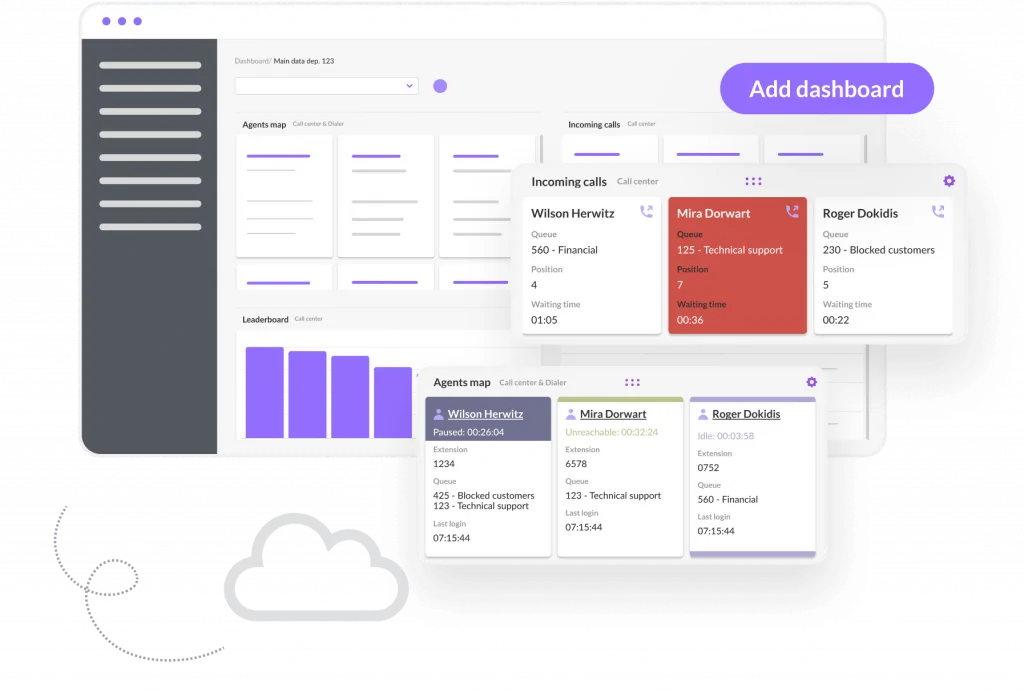
Book a demo call now with one of our sales reps to find out how VoiceSpin’s call center solution caters to your team’s needs.
